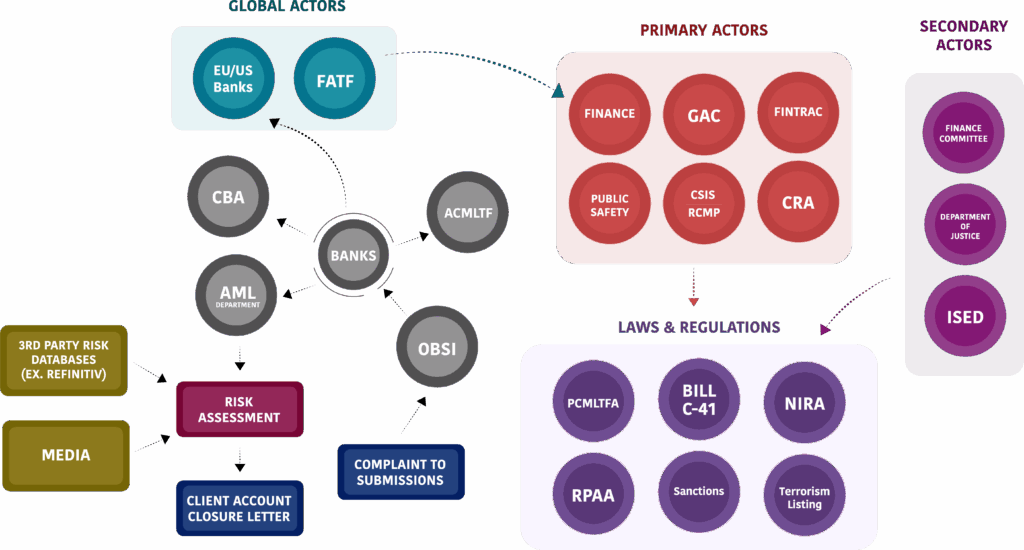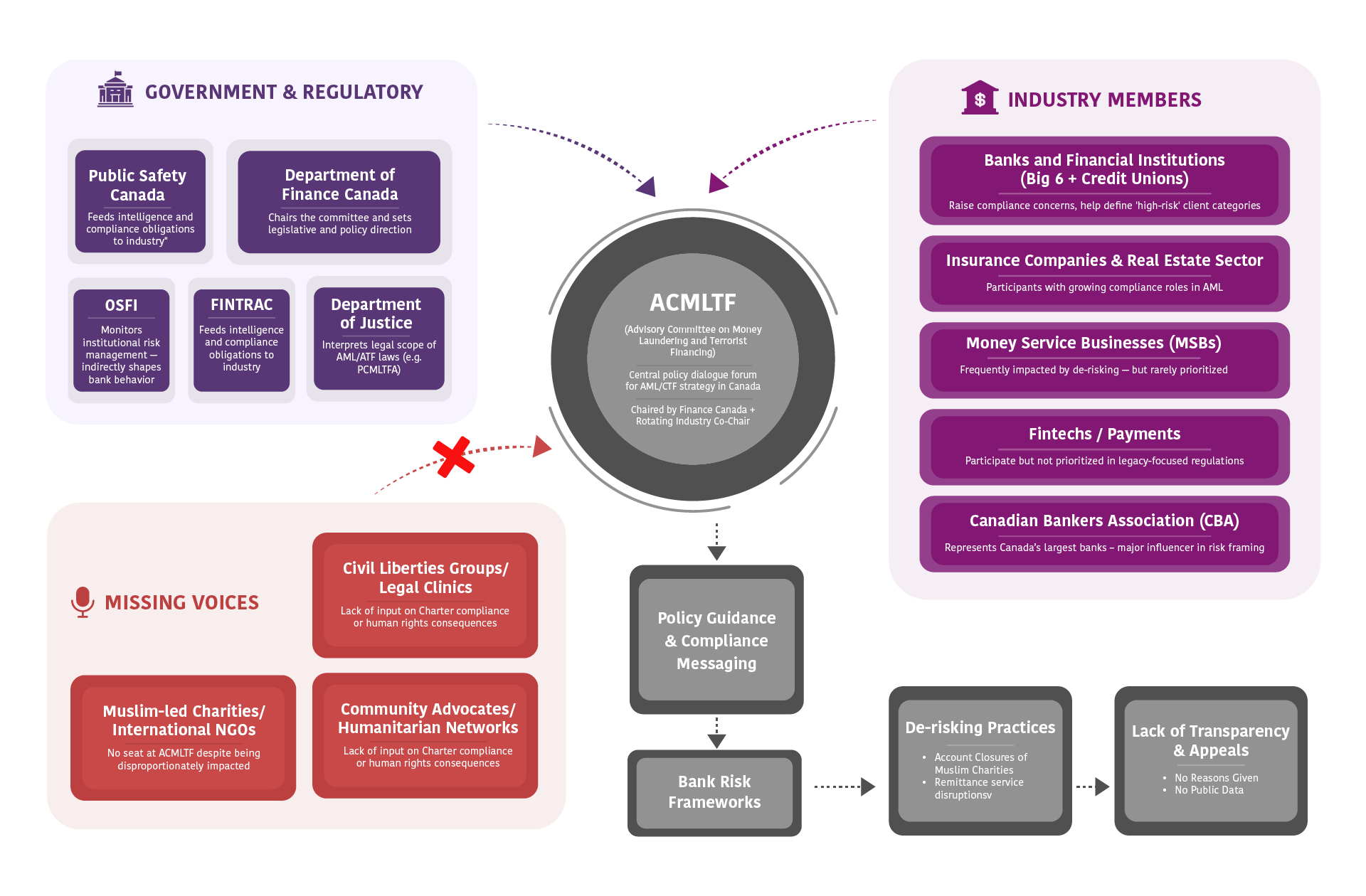The Ecosystem Behind De-banking in Canada
Why Muslim-led and humanitarian charities are being shut out of the financial system — and who’s responsible.
The Policy Ecosystem and Its Disproportionate Impact on Muslim Charities
De-banking isn’t caused by a single law or agency. It’s the result of a complex ecosystem where banks, regulators, intelligence agencies, and government departments interact — Muslim-led and humanitarian charities are disproportionately caught in this web. Here’s how the system works, who the key players are, and why change is urgently needed.
The De-Risking Framework

Government Players
- Department of Finance Canada
-
- Writes Canada’s anti-money laundering law: the PCMLTFA.
- Promotes a “risk-based approach,” but its focus on terrorism financing has made banks overly cautious.
- Its own risk assessments label Muslim-led and humanitarian charities as high risk — setting the tone for the entire system.
- In 2023, it acknowledged de-risking as a concern and launched consultations.
- Finance Canada’s Advisory Committee on AML/ATF (ACMLTF)
-

- Brings banks, regulators, and law enforcement together to shape AML/ATF policies.
- Civil society has no seat — affected charities are excluded from the table.
- Without diverse voices, risk policies lean toward caution, not inclusion.
- House of Commons Finance Committee (FINA)
-
- Oversees AML/ATF legislation and banking access.
- Raised alarms as early as 2015 about overreach and biased data collection.
- Can’t force change, but its public findings and recommendations shape national debates.
- Office of the Superintendent of Financial Institutions (OSFI)
-
- Regulates Canada’s banks and how they manage risk.
- Tells banks to assess risk — but doesn’t stop them from overcorrecting by exiting entire sectors.
- Its high compliance expectations create pressure to drop high-risk clients, even without wrongdoing.
- RCMP & CSIS
-
- Feed banks intelligence alerts and risk indicators — even without charges or listings.
- Banks react swiftly to this “pre-criminal” information.
- Case example: IRFAN-Canada was de-banked years before being officially listed as a terrorist entity.
- FINTRAC – Financial Intelligence Unit
-
- Collects and analyzes reports from banks.
- Its strict rules and penalties create a “zero-tolerance” culture.
- Warns against blanket de-risking — but banks often overreact out of fear.
- Banks interpret ethnicity, religion, or geography as proxies for risk, contributing to profiling.
- Canada Revenue Agency (CRA) – Charities Directorate & RAD
-
- Audits charities for possible terror financing.
- 85% of charities audited and revoked under RAD were Muslim-led and humanitarian charities.
- CRA’s red flags ripple across agencies and banks, even when no wrongdoing is found.
- Risk information spreads — but exoneration rarely does.
- Department of Justice Canada
-
- Crafts legal interpretations of anti-terror laws.
- Broad definitions (e.g. pre-C-41 law) created legal risks for legitimate aid.
- Has the power to clarify that discriminatory de-risking violates Charter rights.
- Financial Consumer Agency of Canada (FCAC)
-
- Protects individual consumers — not organizations.
- Can’t force a bank to explain or reverse account closures.
- Doesn’t collect public data on who’s being de-banked — major accountability gap.
- Innovation, Science & Economic Development Canada (ISED)
-
- Oversees nonprofit transparency and corporate registries.
- Better data sharing from ISED could reduce banks’ uncertainty about charities.
- Supports fintechs — but banks still hold the final power to cut ties.
- Global Affairs Canada (GAC)
-
- Administers sanctions and humanitarian exemptions.
- Can issue permits under Bill C-41 for charities operating in conflict zones.
- Tries to keep aid channels open — but banks often ignore or sidestep its exemptions.
Legal and Regulatory
- PCMLTFA (Proceeds of Crime and Terrorist Financing Act)
-
- Canada’s main AML/ATF law.
- Enforces a risk-based approach — but vague guidance leads banks to err on the side of caution.
- Revisions in 2008 sharply expanded penalties and scrutiny, triggering sector-wide de-risking.
- FATF Recommendation 8
-
- International standard labeling nonprofits as vulnerable to terror financing.
- “Soft law” — but enforced domestically as if it were binding.
- Canada’s interpretation is harsher than other G7 countries.
- Result: Muslim-led and humanitarian charities face stricter audits and banking restrictions.
- National Inherent Risk Assessments (2015 & 2023)
-
- Government reports that labeled charities as “high-risk” without accounting for controls.
- Banks use these labels to justify account closures.
- Ignores residual risk — the actual risk after oversight, compliance, and controls are applied.
- Bill C-41 (2023) – Humanitarian Exemption Reform
-
- Created legal paths for charities to work in terrorist-controlled areas.
- Provides automatic exemptions for life-saving aid, and permits for development work.
- Still leaves grey zones — banks often stay cautious, blocking wire transfers anyway.
- Bank Act & Retail Payment Activities Act (RPAA)
-
- The Bank Act guarantees personal banking rights — but not for organizations.
- RPAA regulates fintechs — but doesn’t require banks to serve them.
- Both laws give banks wide leeway to cut ties based on risk appetite.
- ACCS Report #4 – Inherent vs Residual Risk
-
- Recommends shifting Canada’s risk model to reflect real, mitigated risks.
- Highlights that compliance and audits reduce actual risk — and policy should reflect that.
- Aligns with global best practices and FATF’s updated position.
Banking Sector’s Role
- Canadian Bankers Association (CBA)
-
- Represents Canada’s major banks.
- Advocates for risk-sharing and clearer regulations — but doesn’t oppose de-risking.
- Defends banks’ discretion to exit clients based on internal policies.
- Ombudsman for Banking Services and Investments (OBSI)
-
- Handles banking disputes — but can’t reverse account closures.
- Offers little recourse for de-risking victims beyond delay or notice extensions.
- Recommends affected individuals pursue human rights complaints.
- AML/CFT Departments in Banks
-
- These internal teams manage risk based on compliance, not inclusion.
- Incentivized to avoid risk at all costs — even if that means dropping legitimate clients.
- Often staffed by ex-law enforcement or security professionals who act conservatively.
- Use secretive algorithms, internal scoring, and third-party data (e.g. World-Check) to flag clients.
A System That Protects Itself — But at What Cost?
De-banking is not accidental — it’s the outcome of a system optimized for risk avoidance, not fairness. Muslim-led and humanitarian charities — particularly those doing humanitarian work in conflict zones — bear the brunt of this design.
Know Your Rights